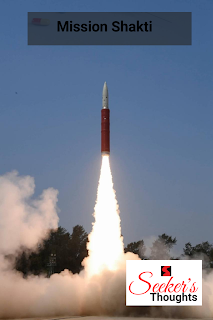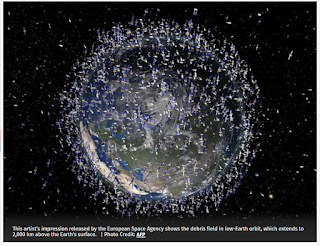The Mission Shakti has been controversial as NASA has said that it has increased the debris in space. The head of National Aeronautics and Space Administration (NASA) today branded India's destruction of one of its satellites a "terrible thing" that had created 400 pieces of orbital debris and led to new dangers for astronauts aboard the International Space Station (ISS).
Influential businessman Anand Mahindra today said the US was being hypocritical after the country's space agency NASA termed India's anti-satellite missile test or ASAT test a "terrible, terrible thing."
What is Mission Shakti?
 |
| www.seekersthoughts.com |
What is Mission Shakti?
Mission Shakti is anti-satellite
system (A-SAT) developed by India’s Defence Research and Development Organization.
Prime Minister Narendra Modi on 27th
March, 2019 announced that the DRDO-developed anti-satellite system A-SAT
successfully destroyed a live satellite in the Low Earth Orbit.
However, the satellite was about
300 km away from earth but no details were shared regarding its ownership and
what the satellite was used for and what were the reasons for choosing that
particular satellite for the test.
What will Mission Shakti or ASAT System do?
A-SAT or Mission Shakti can
destroy a satellite in the Low Earth Orbit or LEO. They are missile-based systems to attack
moving satellites from the ground.
These are satellites roughly at an
altitude of 2,000 kilometres from the earth and that’s the region where
majority of satellites are concentrated.
A database from the Union of Concerned
Scientists, a non government organisation based in the United States, says that
there are at least 5 known Indian satellites in LEO: India PiSat, Resourcesat
2, Radar Imaging Satellites 1 and2 and SRMsat.
What are
other Nations to have the ASAT Technology?
US, Russia and China have this
technology, and since India also tested. India has become 4th country
to join elite country.
What
caused the ASAT technology? - The History
The development of such systems
has a long history — fuelled by the Cold War between the United States and the
former Soviet Union.
In the
Cold War/Space Race era, 1985 was the last time that the United States had used
an anti-satellite system to destroy its P-781 satellite that had instruments
aboard to study solar radiation.
Anti-satellite
weapons came back into popular currency after China conducted an anti-satellite
missile test on January 11, 2007.
The government officially
confirmed this only on the January 23, after report after US.
 |
| Read About- Parker Solar Probe |
The target was a Chinese weather
satellite — the FY-1C – that sailed at an altitude of 865 kilometres (537 mi).
A year later, the United States
launched ‘Operation Burnt Frost,’ the code name to intercept and destroy a
non-functioning U.S. National Reconnaissance Office (NRO) satellite named
USA-193.
What are India’s capabilities so far?
While 'Mission Shakti' may have targeted an object in outer space, India has long developed the ability to intercept incoming missiles. In 2011, a modified Prithvi missile, mimicked the trajectory of a ballistic missile with a 600-km range.
Radars at different locations swung into action, tracking the “enemy” missile, constructing its trajectory and passing on the information in real time to the Mission Control Centre (MCC) to launch the interceptor, an Advanced Air Defence (AAD) missile. It had a directional warhead to go close to the adversarial missile before exploding to inflict damage on it.
 |
| Download Now |
Will the
test spur space weaponization?
Prime Minister Narendra Modi, while announcing the success of the test,
was clear that India wanted to maintain peace rather than indulge in
warmongering.
And, by targeting a low-orbit
satellite, the missile test did the utmost possible to minimise space debris,
which is an issue of international concern.
But, within India, the timing of
the test, when the country is already in election mode, does raise concerns
whether this was aimed at the domestic constituency.
ASATs are
controversial
Anti Satellite Tests are ‘extremely
controversial’ due to two reasons. The first reason is that it contributes
towards the weaponization of space.
The weaponization of space is
prohibited under the Outer Space Treaty of 1967.
PM Modi was careful to state that
India’s test was a “defensive” move, aimed at securing its space
infrastructure, and does not change India’s strong opposition to weaponization
of space.
Second reason is that it increases
the debris in outer space.
 |
| Know More! |













No comments:
Post a Comment